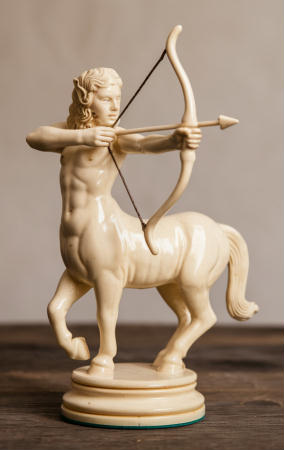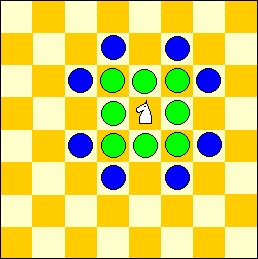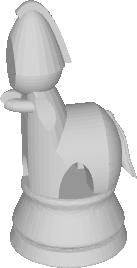Piececlopedia: Centaur
Historical notes

The Centaur has been used in Typhoon and Jupiter by Adrian King, who calls it a Centaur, because it can move as a Man or as a Horse (Knight). It is also called a Centaur by fairy problemists. This piece can be found in these other games under a variety of different names:
- Courier-Spiel by Albers, 1821: (Councellor)
- Renniassance Chess by Eric V. Greenwood, 1980 (Page)
- Royal Court by Sidney LeVasseur, 1998 (Crowned Knight)
- Cobra Chess by Derick Peterson, 1998 (Duke)
- Jupiter by Adrian King, 1999 (Centaur)
- Fantasy Grand Chess by Peter Hatch, 2000 (Wolf Rider)
- Kung Fu Chess by Tim Bostick, 2001 (Tiger)
Fergus Duniho has used a royal version of a Centaur in several variants. He has called it a Knight King in Cavalier Chess and Grand Cavalier Chess, where it is the sole royal piece. And he has called it an Eques Rex in Fusion Chess and several hybrids of this game, such as the triple-hybrid game Thunder Chess. In these games, it is one of four possible royal pieces. The royal Centaur is really a compound of a King and a Knight.
Movement
The Centaur is a compound piece that moves as Man or Knight. Since a Man is itself a compound of Wazir and Ferz, a Centaur moves as a Wazir, Ferz, or Knight. In other words, it moves one space in any direction, or it leaps as a Knight. It captures in the same way that it moves.
Movement diagram

In this diagram, the blue dots show how it moves as a Knight, and the green dots show how it moves as a Man.
Checkmating
This piece can generally force checkmate against a bare king, with the help of its friendly king. Try it!
Alternate Images
Click on an image to view the full piece set it belongs to.
| Royal Centaur | |
|---|---|
 |
|
Printable Pieces
The following designs are available for printing on a 3D printer. Since the centaur can move as a King or a Knight, it can also be represented as a Crowned Knight. Links are to Thingiverse.




Written by Fergus Duniho and Peter Aronson. Diagram by Sergey Sirotkin.
WWW Page Created: 15 December 2001; Last Updated 16 December 2001.
